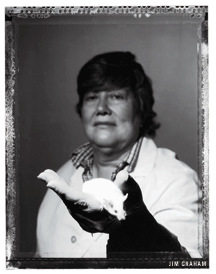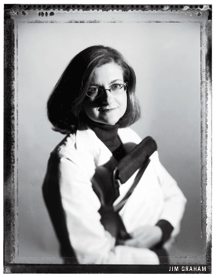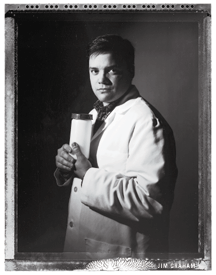Established in 1892 as a museum for anatomic specimens as well as a center for the “increase of original scientific knowledge,” the Wistar Institute today is at the forefront of basic research on cancer, AIDS and other diseases.
By Joan P. Capuzzi Giresi | Photography by Jim Graham

It was pure accident that led Dr. Ellen Heber-Katz to make a 90-degree turn in her research focus. The year was 1994 and, in her investigations on T-cells and their role in autoimmunity, the Wistar Institute researcher was working with a special strain of mouse prone to developing the autoimmune disease lupus. As part of an experiment, Heber-Katz separated the small white critters into two batches, demarcating them by punching ballpoint-sized holes into the ears of one of the groups. A few weeks later, she was confounded to find that all of the holes had mysteriously closed, leaving behind no hint of their former existence, not even a scar.
“When
I saw there were no ear holes,” she recalls, “I didn’t know who was who.”
Laboratory
lemon or scientific serendipity? The future holds the answers. Heber-Katz,
who is also an adjunct professor in the pathology and laboratory medicine
department at Penn’s School of Medicine, now devotes about 80 percent
of her time to mapping the gene loci that confer these unique regeneration
properties and analyzing their patterns of expression. She hopes that
her research on the “healer” mouse—as it was coined at Wistar—which exhibited
full replacement of its epidermis, dermis and cartilage in three to four
weeks following ear puncture, could be a boon to burn victims and might
contribute to research on stem cells, wound healing, and cartilage and
nerve regrowth. But that’s still a long way off. For now, Heber-Katz says,
the leading question on her mind is, “Why are these mice able to do this
and other mice are not?”
Basic
queries like this are what have kept the Wistar Institute at the forefront
of scientific research through the years. Major accomplishments by Wistar
investigators include the identification of a number of cancer-causing
genes, the development of the TALL-104 cells—a promising immunotherapy
currently in clinical testing against several forms of cancer, and the
discovery of interleukin-12 (IL-12)—a messenger protein important in facilitating
immune response to infection. Among the first research institutions to
develop monoclonal antibodies, which can detect and destroy foreign invaders,
including cancer cells, Wistar has been responsible for a host of other
noted creations. These include the Wistar rat—the first standardized laboratory
animal—from which over half of today’s laboratory rats are thought to
be descended, and vaccines against rabies and rubella.

The complexity of the work being done at Wistar is rivaled only by its pure simplicity. “Wistar is wholly devoted to basic research,” says Dr. Frank J. Rauscher III, professor and deputy director of the Institute’s cancer center. “Basic research” at Wistar runs the gamut, from the study of the fruit-fly genome and the remarkable immune systems of insects to investigations of the molecular mechanisms of cancer. The pursuit of the latter occupies the bulk of the lab space and brain power at Wistar today.
The other hallmark of Wistar-style scientific exploration is that it is hypothesis driven. “Ninety-eight percent of our experiments don’t work,” Wistar professor Ellen Puré confides. “At a drug company, if an experiment doesn’t work, it stops there. At Wistar, a failed hypothesis goes on to a new hypothesis and new experimentation.” Hence the unwritten guiding principle at Wistar: Go where the science leads. For Heber-Katz, this progressive approach allowed her to rapidly shift direction in her research from autoimmunity to cellular regeneration.
In a different way, Rauscher has also followed where the seductive and meandering trail of science has led. In the mid-1990s, he was studying the intricacies of zinc- and RING-finger proteins, genetic proteins that modulate gene function. At the time, a group of scientists in Utah discovered the BRCA1 gene, which, when mutated, renders a woman’s chances of developing early-onset breast or ovarian cancer over 80 percent. When Rauscher realized that the protein coded for by this gene was a member of the protein family he’d been studying, he became elated and headed into the director’s office. “‘Look,’ I said to him, ‘I think I can make an impact here, but I need some basic support.’”
Support was granted, and Rauscher and his team went on to discover the gene BAP1, which has the dual function of regulating BRCA1 levels and controlling its activities. Rauscher hopes eventually to identify drug receptors on oncogenes—the genes that activate the uncontrolled cell growth of cancer. He says that the discovery of BAP1 makes it possible to genetically test for its presence and then potentially use it as a target for cancer-fighting drugs.
As
an institute,
Wistar has been able to evolve with the science from the beginning. The
Wistar Institute of Anatomy and Biology—as it was formerly known—was founded
in 1892 by Civil War general Isaac J. Wistar, a successful lawyer, businessman
and cultural leader, to house a medical museum begun years earlier by
his great uncle, Dr. Caspar Wistar, who chaired the department of anatomy
at the University’s School of Medicine. The younger Wistar funded the
construction of the four-story Victorian building that housed the collection
and established an endowment in exchange for the University’s commitment
to provide a plot of land bounded by Spruce Street, 36th Street and Woodland
Avenue. In addition to housing a museum, the new institute, he declared,
would be free to initiate “any other work for the increase of original
scientific knowledge.”
By
the early 1900s Wistar’s third director declared the institute the nation’s
“clearing house of anatomy.” Isaac Wistar quickly clarified the purpose
of the museum—which included anatomic and embryologic anomalies, such
as the skeletons of conjoined twins and the skeleton of a baby with only
one eye orbit, as well as the brains of its founder and other famous scientists—as
“for the use and study of investigators; rather than a mere gaping public.”
Soon Penn graduate students, as well as scientists from all over the world,
would train in Wistar’s laboratories and use museum specimens in their
studies. The institute began to publish several international medical
journals and, by 1925, was the epicenter of American biology. Its museum
was no longer the focal point, and eventually the specimens began to collect
dust. Legend has it that in the 1950s, Wistar’s museum was named to Philadelphia
magazine’s list of best places to meet for an illicit love affair, because
of its low foot traffic. (Much of the original collection is now on permanent
loan to other museums; the remaining specimens have been relegated to
a climate-controlled storage closet in the basement.)
The
modern era of the Wistar Institute began with the 1957 appointment of
Polish-born scientist Dr. Hilary Koprowski as director. During his 34
years at the helm, Koprowski lent an international flavor to the institute
and staked out a clear new direction: basic research, with an emphasis
on virology and immunology. In the early years of his tenure, vaccine
development flourished at Wistar. But eventually, Koprowski’s focus shifted
to cancer research. In 1972, it became one of the first institutions designated
by the National Cancer Institute (NCI) as a federally approved basic-science
cancer center. With NCI and private funding, a new cancer wing was appended
to the original building a year later. The Koprowski years also saw major
advances in the areas of tumor immunology, monoclonal antibody production
and oncogene research.
Under
Dr. Giovanni Rovera, who took over as Wistar’s director in 1991, the institute
emphasized technology transfer. While cancer remained the major thrust
of its work, autoimmune diseases like lupus and rheumatoid arthritis were
also given emphasis. Major discoveries about the body’s immune response
to cancer and about HIV emanated from Wistar’s labs. And Rovera hired
a staff of molecular biologists to direct Wistar on a new path: molecular
and gene-based therapies, which today are widely touted as the key to
controlling many human diseases, from cancer and AIDS to cystic fibrosis
and cardiovascular disease. With Rovera’s retirement this past October,
the Wistar Institute is now at a crossroads. The search for a new director,
which began a year ago, continues.

Wistar’s acting director, Dr. Clayton Buck, speaks in carefully measured words as he describes the type of leader the Institute is looking for. “We want someone who can recognize good science and has a nose for future directions in science,” says Buck. The lucite Macintosh computer that sits on the large mahogany desk in his office seems chronologically out of place across the room from the century-old, ornately chiseled, oak fireplace. Surrounded by neat piles of paper—the letter he’s sending to Congress regarding NIH funding, the cancer center grant documents he needs to review, the scientific journals that he wishes he had time to read, he adds to the list of qualifications. The new director, says Buck, who plans to retire once his replacement is named, must have a keen working understanding of “translational research”; no ivory tower autocrat, he or she must be able to bridge scientific observation with public health utility. And, perhaps most importantly, this new director needs to possess the charisma to sell Wistar to the public, raise money to keep the institute operating, and form relationships with foundations that could lead to more grants for Wistar investigators.
The importance of this last qualification is not lost on Dr. Claudio Basilico, chair of the microbiology department at the New York University School of Medicine and a member of Wistar’s external scientific-advisory committee. “Science is expensive nowadays,” he says. “In science, you need money to make money” to fund research. Indeed. Wistar’s 1999 operating budget was over $28 million.
Each investigator at Wistar is responsible for procuring his or her own research funds. “We’re a soft-money institution,” Buck explains, “so if you can’t get money, you can’t work.” Though the investigators obtain most of their research dollars from the National Institutes of Health (NIH), the Commonwealth of Pennsylvania, foundations and private donors, a key component of the institute’s funding comes in the form of a core grant from NCI, to whom the investigators must submit their research budgets every five years.
When Wistar became a national cancer-research center in the 1970s, it hired a group of young, progressive hotshots in the cancer field. With extremely low researcher turnover at Wistar, the original faculty remains mostly intact and now directs the institute’s mission. Today, cancer is clearly the flagship disease. Ninety percent of the labs are engaged in cancer research, and the rest of them are doing work that somehow relates to cancer, even if peripherally so.
While cancer research is central to Wistar’s mission—and the source of the great bulk of its funding—the administration hopes to double its working labs to about 50 and, says Basilico, branch out in new research directions. Since NCI contributes substantial research dollars, diversifying outside of the realm of cancer will be difficult unless new sources of funding are identified. And surely, money and leadership are prerequisites for quality research. “If they don’t find a new director relatively soon and get more money soon, the good researchers here will start to leave,” Basilico says.
But
these problems are universal
in the realm of scientific exploration. Researchers everywhere complain
about the obstacles they deal with to obtain funding for their work, says
Wistar professor Dr. Meenhard Herlyn. Since grants and scientific productivity
are tightly tethered, Herlyn explains, Wistar’s administration has learned
to cater to the research. The grants office, for example, formats and
prepares grant proposals for investigators so that they need only spend
their grant-writing time on the science and their budgetary needs. The
development office identifies donors who might want to underwrite specific
research projects.
Buck
calls Wistar “the best of all possible worlds for a researcher.” The Institute
is relatively small and administratively streamlined. Investigators have
virtually no bureaucratic obligations or teaching responsibilities to
eat up their time. And they have access to all the assets Penn has to
offer, including libraries, seminars, patient samples and graduate students,
who come to work in their labs.

Though Wistar is a separate and independent entity, it has a strong history of research collaboration with Penn. Some of the researchers at Wistar hold joint appointments at the University and many Penn degree candidates do much of their accreditation work at Wistar. As a result, there’s no shortage of comparisons between the two institutions.For example, Wistar, unlike Penn, can be likened to a farmer’s market, where everyone has his own stall. The institute, which boasts a 50 percent rate of Ph.D.s among its 300 or so employees, is populated by independent labs with little overlap in their specific fields of expertise. Yet Wistar fosters interdisciplinary interaction that allows the scientists to share, and use, each other’s knowledge. Ellen Puré, who studies the inflammatory mechanisms behind atherosclerosis, says her research benefits, for instance, from the interaction she has with the molecular genetics group down the hall and the structural biologist next door. By contrast, she says, Penn is so big that one needs to really work at getting to know another’s research.
But what Penn offers to Wistar is an enormous supply of M.D.s who are in the trenches and can deliver patient samples for research purposes. An additional benefit: the possibility for unique fusions of the clinical and the research perspectives, says Puré. She explains that a doctor might remark to her, “‘I have a patient that lacks the enzyme that results in this phenotype. Can we think about this problem together?’” A place like “Wistar-Penn” is fertile ground for such collaborations, she says. “We need these two types of people talking so that they can connect the dots.”
In her research on atherosclerosis and airway inflammation associated with asthma, Puré works closely with several physicians within the University of Pennsylvania Health System, including pulmonary specialists and an internist who specializes in lipid disorders. While both of these disease processes share a common enemy—inflammation—Puré foresees atherosclerosis to be the domain in which she may have the most immediate clinical impact. Puré hopes to combat this battle in the vessels by identifying the genes and molecular mechanisms that facilitate the atherosclerotic process. She studies the receptors in the blood vessel that allow for the adhesion of the inflammatory cells that comprise plaques, and she has uncovered the role of a significant receptor—the CD44 molecule—in the development of plaques that may be more susceptible to rupture and clot formation leading ultimately to heart attack or stroke.
The mechanisms that underlie chronic inflammatory disease, which are also key players in tumor metastasis, are potential targets for new drugs aimed at preventing atherosclerosis and other inflammatory conditions, she says. But this pathologic machinery cannot be manipulated until it is understood.
“There’s been a lot of discussion about getting all of this basic research to be translated into human healthcare,” Puré adds. The conventional wisdom, she continues, has been to “get M.D.s to do science. And then everyone said, ‘Let’s get people with combined degrees to do science.’ But neither solution has worked completely.” She believes that the therapies of tomorrow will come from basic scientists—working with research tools like lab mice and test tubes—in collaboration with their counterparts in the clinical world.
Dr. Thanos Halazonetis, assistant professor at Wistar, is busy mapping the distinctions between tumor cells and normal cells, and defining certain “checkpoint” genes that, when mutant, fail to assume their normal function of inhibiting cells from entering into the spiraling growth patterns of cancer. He laments the fact that basic science is given little popular attention. “The people think that their doctor will figure out better ways to treat cancer. But that’s not going to happen,” he says. “If the public understands that laboratory research is important for the development of new therapies, then so will the politicians.” In his laboratory just inside Wistar’s elegantly marbled, first-floor atrium, to the left of the steep grand staircase, Halazonetis walks past a row of large beakers filled with yellowish liquid. He stops for a moment to make a prediction—that his exhaustive research on seemingly esoteric bits of DNA will materially improve the way in which doctors treat patients within the next 20 years.
Wistar’s melanoma research lab, headed by Meenhard Herlyn, is the institute’s largest laboratory. It also comprises the largest melanoma research group outside of the NIH. Like Halazonetis, Herlyn hopes to advance clinical medicine through his bench work. Herlyn describes a study conducted a few years ago in which seven world-class pathologists were given 38 samples of lesions that represented either melanoma or dysplastic—abnormally-growing—tissue. Shockingly, the doctors disagreed on their diagnoses in 40 percent of the cases.
Herlyn is striving to understand the early changes that take place in the growth of melanomas, and to develop highly accurate molecular models that will help pathologists to better diagnose them. He notes that the cure rate for melanoma is about 100 percent when it is caught and treated early. And by better defining the transcription factors that promote the proliferation of melanoma cells, Herlyn hopes to pinpoint ways in which chemotherapy and radiation could be rendered more effective in treating melanoma.
Unfortunately, this research did not come soon enough to save Noreen O’Neill, who died last summer of metastatic melanoma. O’Neill was president of the Foundation for Melanoma Research, an organization that Herlyn cofounded with a group of melanoma patients. Herlyn continues to be inspired by O’Neill’s plight, from which, he says, “it became clearly obvious to me that therapy for melanoma is very much in its infancy.”
To better characterize the behavior of melanoma cells, Herlyn, who has been engaged in melanoma research since 1977, uses a mouse model to cultivate the disease. He grafts human skin, which he obtains from surgeons at the Hospital of the University of Pennsylvania, onto the backs of his mice. He then injects them with growth factor and places them under ultraviolet lights. After about three months, some 10 percent of the mice have melanoma lesions, which are then harvested, grown in tissue culture, and analyzed during their successive growth phases. Herlyn scrutinizes the abnormal melanocytes to determine how they escape the control of the keratinocytes, which are the normal cellular gatekeepers in this growth process. And he also tries to ascertain which genes are the culprits in transforming the melanocytes from normal to aberrant cells.
Dr. Louise Showe, an associate professor and core facility director at Wistar, runs the microarrayer that Herlyn and some of the other cancer researchers hope to soon rely on to better define the differences between normal and cancerous cells. Showe, who last year received a five-year, $500,000-a-year NCI grant to develop microarray technology at Wistar, produces arrays that consist of spots, or “probes,” of DNA for 1,700 selected genes. RNA is extracted from the cells—melanoma cells, for example—that are under investigation. Copies of the RNA are then produced, each incorporating a radioactive tag. Once brought into contact with the DNA probes, these RNA targets bind to the probes that correspond to the genes that generated them. The resulting DNA-RNA complexes are read radiographically to assess which genes in the study sample are active, and how strongly they are expressed.

Preventing the most threatening diseases of our time has been a primary objective at Wistar for decades. Professor Hildegund Ertl, who came to Wistar 13 years ago to work on vaccine development for rabies, continues the Institute’s strong tradition of vaccine development. Today, she focuses on two other major killers: cervical cancer and AIDS.
The
second leading cause of cancer mortality in women worldwide, cervical
cancer is linked to sexually-transmitted infection with certain strains
of human papilloma virus. These viral strains produce proteins that transform
normal cells into malignant ones. Ertl’s lab is developing a vaccine,
currently being tested in mice, that targets those nefarious proteins
in order to treat early-stage cervical cancer. The two-tier regimen, Ertl
explains, uses an injected vaccine incorporating viral DNA to prime the
immune system. Then a booster immunovirus—a cold virus genetically modified
to be harmless but to trigger tumor-specific immune protection—is administered
for reinforcement of the immune response.
Tall
and wiry, Ertl gesticulates with her hands as she rapidly fires off staccato
sentences with a heavy German accent, all the while staring at her listener
with the intensity of one who is urgent to convey the meaning of her thoughts.
When the topic switches to vaccine development against HIV, Ertl becomes
less forthcoming. “We have something up our sleeves that we don’t want
to talk about yet,” she remarks dismissively, with a mischievous grin
that reveals her obvious verve about the project. What she will say about
HIV vaccine development is this: It’s tricky. One can imagine the disastrous
consequences of a modified-live HIV vaccine somehow converting to a state
of virulence. Yet killed HIV, she says, would be impotent in inducing
an adequate immune response to HIV. The answer, she explains, lies in
some sort of recombinant that incorporates genetic material from a virus
other than HIV that would launch an immune response against actual HIV.
Trained
as a physician in Germany, Ertl decided long ago to move into the laboratory
after becoming disillusioned with the practice of medicine. “I found it
incredibly frustrating that I was giving these medications and did not
know exactly how they worked.”
For
Ertl, vaccine research was an ideal fusion of her intellectual and altruistic
pursuits. “When I was a kid,” she recalls, “I saw a lot of people crippled
by polio. Developing vaccines is a way of helping not just one person,
but millions.”
And
possibly hurting millions, if you ask a vocal faction who maintain that
HIV was introduced into the human race through vaccines created in Wistar
labs. According to a theory promulgated by British journalist Edward Hooper
in his 1999 book, The River, an oral polio vaccine prepared at
Wistar and administered to people in the former Belgian Congo in the late
1950s provided the route of transmission for HIV or HIV-related viruses
from chimpanzees to people. Much of Hooper’s claim was based on the assumption
that chimpanzee cells were used in the preparation of the vaccine.
The
former Wistar scientists who developed the vaccines—prior director Koprowski
and Dr. Stanley Plotkin—have long maintained that no chimpanzee cells
were used in the preparations. Recent tests performed by three independent
laboratories failed to find any traces of simian immunodeficiency virus
(SIV), HIV or chimpanzee DNA. [“Gazetteer,” November/December, “Letters,”
January/February, and this issue.] Yet some critics charge that the few
samples that were tested were not representative of the whole, that chimpanzee
tissue was lurking somewhere. Plotkin, who is now an emeritus professor
of pediatrics and microbiology at Penn’s medical school, states that the
sole simian source for the vaccines is kidney tissue from the macaque.
But the allegations may never completely evaporate, he laments, because
“you can’t prove a negative.”

For all of our scientific progress, we may never learn the true origins of HIV. But we may be getting close to treating it successfully, if Luis Montaner gets his way. Montaner, an associate professor who runs the only Wistar lab that deals exclusively with HIV, began to study the effectiveness of HIV drug treatment interruptions in reducing viral load about five years ago. At the time, doctors wanted to limit the amount of drug they used to treat their patients because these “cocktails” were very costly, burdensome to take correctly, and often accompanied by disturbing and potentially dangerous side effects. When Montaner looked at the problem, he found that drug “holidays” were actually a better bullet. In his study, published in the September 2000 issue of the Journal of Infectious Diseases, drug-treatment interruptions were, for the first time, shown to boost HIV-specific immune responses in chronically infected patients, as compared to a matched control group that was not on any medication [“Gazetteer,” November/December].
Montaner’s group is now recruiting HIV-infected patients for a new, larger study that will test the effects of carefully controlled interruptions in HIV drug regimens (four interruptions over a period of 46 to 80 weeks) on the immune response to the virus. Working in conjunction with infectious disease specialists in Penn’s Health System and at Philadelphia FIGHT, a community-based HIV clinic, Montaner believes that the potency of the drug treatment allows the patient’s immune system to recover. During the first treatment interruption, the virus that is once again presented to the immune system provides an “autovaccination” of sorts. Subsequent drug interruptions following treatment periods are like the “boosters,” coaxing greater immune responses that further reduce the viral load.
Wistar’s growth has always been molded by forces like AIDS that could not be anticipated—emerging diseases and dawning knowledge. In light of these unpredictable variables, the institute’s future is full of unwritten chapters. But certainly Wistar today embodies the vision of its founder, Isaac Wistar. As he gave of his time, his wisdom and his fortune to build the institute, Wistar once said, “We are not constructing a mere plaything for our own time, but an enduring monument for a far-stretching future.”
Dr. Joan Capuzzi Giresi C’86 V’98 is a journalist and practicing veterinarian in the Philadelphia area.




